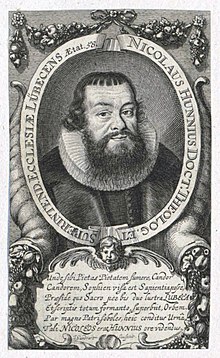Nicolaus Hunnius
This article includes a improve this article by introducing more precise citations. (May 2014) ) |

Nicolaus Hunnius (11 July 1585 – 12 April 1643) was an
Lutheran scholastic
tradition.
Hunnius was born at
University of Wittenberg
, where he studied philology, philosophy, and theology. In 1609 he joined the philosophical faculty and lectured in philosophy and theology. He followed the same theological direction as his father, inherited his temper and talent as a polemist, and was like him, possessed of great learning. In virtue of his
ability Reformed. To check the proselytizing tendencies of the Roman Catholics, he even invoked the aid of the secular powers. At the same time he made earnest efforts to elevate the religious and ecclesiastical life. He died at Lübeck
, aged 57.
Works
It was however, chiefly his polemical literary activity that made Hunnius known among his contemporaries. He wrote against the Roman Church Ministerii Lutherani divini adeoque legitimi demonstratio (Wittenberg, 1614) and Capistrum Hunnio paratum, etc. (1617); against the
Socinians, whom he considered as Photinians, Examen errorum Photinianorum, 1620); and against the enthusiasts, Christliche Betrachtung (1622), Nedder Sächsisches Handtbaeck (Lübeek, 1633), Ausführlicher Bericht von der neuen Propheten Religion, Lehr und Glauben, etc. (Lübeck, 1634; 2d ed. by J. H. Feustking, Wittenberg, 1708, under the title Mataeologia fanatica). Against the unionistic tendencies of John Durie he wrote Ministerii ecclesiastici Lubecensis theologica Consideratio interpositionis, seu pacificatoriae transactionis, inter religionen Lutheranam ex una, et Reformatam ex altera parta profitentes, abs D. Johanne Duraeo, ecclesiaste Britanno, his temporibus tentatae (Lübeck,1677). Another writing during his activity at Lübeck is his Diaskepsis theologica de fundamentali, dissensu doctrinae Evangelicae Lutheranae et Calvinianae seu Reformatae, (Wittenberg, 1626), which is important in so far as the distinction between fundamental articles
and non-fundamental articles of faith may be traced to it. (An English translation of “Diaskepsis theologica” was published in 2001.) But the greatest sensation was created by his Consultatio oder wohlmeinendes Bedenken, ob und wie die evangelisch-lutherischen Kirchen die jetzt schwebenden Religionsstreitigkeiten entweder beilegen oder durch christliche und bequems Mittel fortstellen und endigen mögen (Lübeck, 1632).
Here he proposed the institution of a perpetual theological senate for the purpose of
investigating and settling all theological disputes. Among his didactic writings may be mentioned the Epitome credendorum oder Inhalt der christlichen Lehre, etc. (Wittenberg, 1625). This work ran through nineteen editions, and was translated into Dutch, Swedish, Polish, and Latin. It is a book of popular instruction in Christianity, was reprinted in 1844 for
the seminary of American missionaries at Wilhelm Löhe
), and a third edition appeared at Nördlingen, 1870. An epitome of it was made the basis of religious instruction in elementary schools.
References
 This article incorporates text from a publication now in the New Schaff–Herzog Encyclopedia of Religious Knowledge (third ed.). London and New York: Funk and Wagnalls.
This article incorporates text from a publication now in the New Schaff–Herzog Encyclopedia of Religious Knowledge (third ed.). London and New York: Funk and Wagnalls.{{cite encyclopedia}}: Missing or empty|title=(help)[1]
